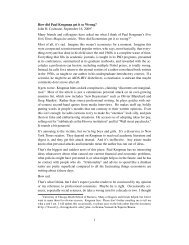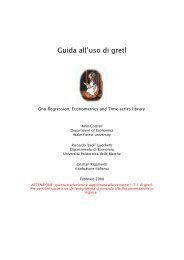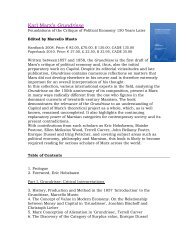The Labor Market of the Early Roman Empire - Wake Forest University
The Labor Market of the Early Roman Empire - Wake Forest University
The Labor Market of the Early Roman Empire - Wake Forest University
Create successful ePaper yourself
Turn your PDF publications into a flip-book with our unique Google optimized e-Paper software.
524 | PETER TEMIN<br />
<strong>The</strong> ve slave societies noted by Hopkins can be classi ed<br />
according to <strong>the</strong>se two dimensions. <strong>The</strong> classi cation can be seen<br />
easily in a two-by-two matrix, as shown in Table 1, where <strong>the</strong> ve<br />
societies are placed in <strong>the</strong> appropriate boxes. Rome, as an open<br />
system <strong>of</strong> slavery with frequent manumission, is in <strong>the</strong> upper lefthand<br />
box. <strong>The</strong> sou<strong>the</strong>rn United States and <strong>the</strong> Caribbean, as a<br />
closed system with almost no manumission, appear in <strong>the</strong> lower<br />
right-hand box. <strong>The</strong> slavery in ancient Greece and in modern<br />
Brazil were intermediate cases. Manumission was common, but<br />
freed slaves were segregated from <strong>the</strong> larger population. <strong>The</strong> remaining<br />
possibility, an open system <strong>of</strong> slavery with no regular<br />
manumission, nds no instance in <strong>the</strong>se ve societies.<br />
Few people would choose to be a slave; almost all <strong>Roman</strong><br />
slaves were forced into slavery as captives, children <strong>of</strong> slaves, abandoned<br />
children, or debt bondage. A <strong>Roman</strong> slave was subject to<br />
more cruelty in <strong>the</strong> early <strong>Roman</strong> empire than free people were.<br />
But even if many slaves were at, or near, <strong>the</strong> bottom <strong>of</strong> society<br />
and <strong>the</strong> economy, it makes sense to ask how hopeless was <strong>the</strong>ir<br />
position.<br />
All people, even slaves, need to have incentives to work. Free<br />
people may work to increase <strong>the</strong>ir income; slaves may require<br />
o<strong>the</strong>r incentives—positive incentives, or “carrots” (rewards for<br />
hard or good work), and negative incentives, or “sticks” (punishment<br />
for slacking <strong>of</strong>f or not cooperating). <strong>The</strong>re is a large literature<br />
on <strong>the</strong> incentive structures <strong>of</strong> modern American slavery,<br />
possibly because its emotional content makes consensus elusive.<br />
But while disagreements remain on many points, most scholars<br />
agree that negative incentives dominated <strong>the</strong> lives <strong>of</strong> modern<br />
slaves in <strong>the</strong> Americas.<br />
Positive incentives were more important than negative in<br />
motivating <strong>Roman</strong> slaves. Sticks can get people to work, but not<br />
to perform skilled tasks that require independent action. It is hard<br />
to distinguish poor performance from back luck when work is<br />
complex, and carrots are far more effective than sticks in motivating<br />
hard work. Consider a managerial job, like a vilicus (supervisor).<br />
A slave in such a position motivated by negative incentives<br />
could claim that adverse outcomes were not his fault. Beating him<br />
useful or agreeable, he might very naturally expect that <strong>the</strong> diligence and delity <strong>of</strong> a few<br />
years would be rewarded with <strong>the</strong> inestimable gift <strong>of</strong> freedom.”







